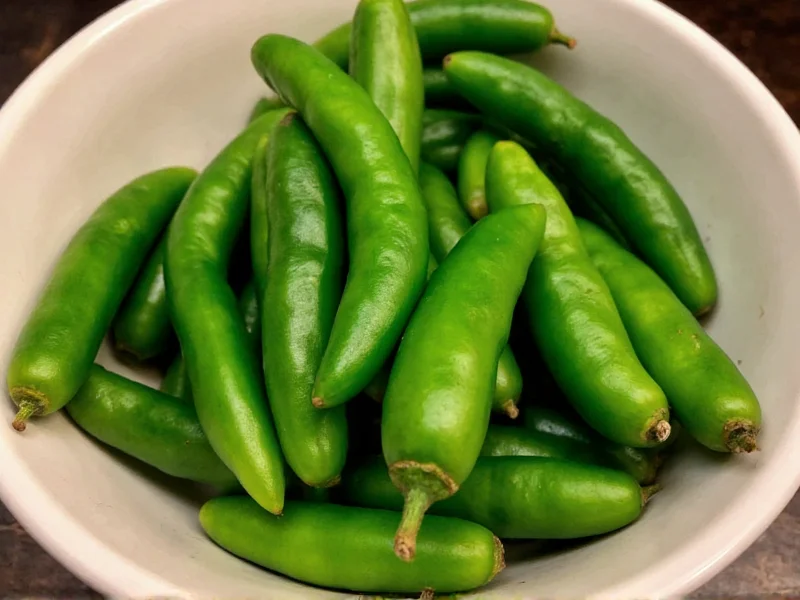When comparing serrano pepper heat level compared to jalapeno, the difference is substantial enough to impact cooking decisions. Understanding this heat disparity helps home chefs and food enthusiasts make informed choices when selecting peppers for recipes. The Scoville scale provides the scientific measurement that confirms serranos consistently outrank jalapeños in spiciness.
Understanding the Scoville Scale for Pepper Comparison
The Scoville scale measures capsaicin concentration—the compound responsible for a pepper's heat. Developed by pharmacist Wilbur Scoville in 1912, this scale assigns numerical values representing heat intensity. Higher numbers indicate more capsaicin and greater spiciness. Modern testing uses high-performance liquid chromatography for precise measurements, replacing Scoville's original subjective taste test method.
Detailed Heat Comparison: Serrano vs Jalapeño
While both belong to the Capsicum annuum species, their heat profiles differ dramatically:
| Pepper Type | Scoville Heat Units (SHU) | Relative Heat Level | Common Culinary Uses |
|---|---|---|---|
| Serrano | 10,000–23,000 | Medium-Hot | Salsas, guacamole, garnishes, pickled preparations |
| Jalapeño | 2,500–8,000 | Mild-Medium | Stuffed peppers, nachos, poppers, sauces, pizza toppings |
This serrano vs jalapeno Scoville scale comparison shows serranos generally deliver 3-9 times more heat than jalapeños. The lowest possible serrano (10,000 SHU) still exceeds the highest possible jalapeño (8,000 SHU), creating a non-overlapping heat range that makes substitution challenging without recipe adjustments.
Factors Influencing Heat Variability
Several elements affect the actual heat level you might experience with either pepper:
- Color maturity: Riper (redder) peppers often develop more capsaicin
- Growing conditions: Stress from less water or nutrient deficiency increases heat
- Seed and membrane content: Most capsaicin concentrates in these areas
- Regional varieties: Mexican-grown serranos often run hotter than California varieties
When evaluating how much hotter are serranos than jalapenos in practical terms, consider that removing seeds and membranes from serranos can bring their heat closer to jalapeño levels, though they'll still maintain noticeable extra kick.
Culinary Implications of the Heat Difference
The significant heat gap between these peppers affects recipe outcomes substantially. Chefs working with serrano pepper spiciness range must adjust quantities carefully when substituting for jalapeños. As a general rule:
- Use ½ to ⅔ less serrano when replacing jalapeño in recipes
- Always taste-test before adding entire quantities
- Consider removing seeds and membranes from serranos for milder results
- Balance heat with dairy, acid, or sweetness in finished dishes
Understanding these differences prevents overly spicy dishes while maintaining intended flavor profiles. The thinner walls of serranos also mean they absorb flavors more readily in pickling applications compared to thicker-walled jalapeños.
Safety Considerations When Handling Hotter Peppers
Working with significantly hotter serranos requires additional precautions compared to jalapeños:
- Wear gloves when handling, especially when seeding
- Avoid touching face or eyes during preparation
- Wash hands thoroughly with soap after handling
- Use separate cutting boards for hot peppers
- Consider ventilation when cooking with large quantities
These precautions become particularly important when exploring can I substitute serrano for jalapeno in recipes, as inexperienced cooks might underestimate the heat difference and create uncomfortably spicy dishes.
Flavor Profiles Beyond Heat
Beyond the heat comparison, these peppers offer distinct flavor characteristics:
- Serranos: Bright, grassy notes with citrus undertones; thinner walls provide quicker heat release
- Jalapeños: Earthier, slightly sweet profile with thicker flesh that provides more substance in dishes
The flavor differences mean that even when heat levels are adjusted through seeding or quantity modification, the final dish will have different flavor characteristics depending on which pepper you choose.
Practical Substitution Guidelines
When considering can I substitute serrano for jalapeno in your cooking, follow these evidence-based recommendations:
- For raw applications (salsas, guacamole): Use 1 serrano for every 2-3 jalapeños
- For cooked dishes: Use 1 serrano for every 2 jalapeños
- For stuffed pepper recipes: Stick with jalapeños unless you specifically want intense heat
- For pickling: Serranos absorb flavors faster but may become overly spicy
Remember that individual pepper heat can vary significantly within the same batch, so always taste a small piece before committing to full recipe quantities.
Conclusion: Making Informed Pepper Choices
Understanding that serranos are consistently hotter than jalapeños—typically by a factor of 3-9 times—empowers cooks to make better ingredient decisions. This knowledge of serrano pepper heat level compared to jalapeno helps prevent culinary disasters while allowing for intentional heat adjustment in recipes. Whether you're crafting the perfect salsa or experimenting with new flavor combinations, recognizing these heat differences ensures your dishes achieve the intended spice profile without overwhelming heat.
Frequently Asked Questions
How much hotter is a serrano compared to a jalapeño on average?
Serranos average 10,000-23,000 Scoville Heat Units (SHU), while jalapeños range from 2,500-8,000 SHU. This means serranos are typically 3-9 times hotter than jalapeños, with even the mildest serrano exceeding the hottest possible jalapeño.
Can I substitute serrano for jalapeño in recipes?
Yes, but with caution. Use approximately half the amount of serrano compared to jalapeño called for in recipes. For raw applications like salsa, use 1 serrano for every 2-3 jalapeños. Always remove seeds and membranes from serranos to reduce heat, and taste-test before adding full quantities to avoid overly spicy results.
Why are serrano peppers hotter than jalapeños?
Serranos contain higher concentrations of capsaicin, the compound responsible for heat in peppers. Their thinner walls and different growing patterns contribute to this increased capsaicin production. Environmental factors like water stress during growth can further increase serrano heat levels beyond their already higher baseline compared to jalapeños.
Which pepper is better for beginners working with spicy ingredients?
Jalapeños are significantly better for beginners due to their milder, more predictable heat range. Their thicker walls make them easier to handle and seed, and their lower Scoville rating provides a more forgiving introduction to spicy cooking. Serranos' higher heat variability and intensity can easily overwhelm inexperienced cooks.











 浙公网安备
33010002000092号
浙公网安备
33010002000092号 浙B2-20120091-4
浙B2-20120091-4